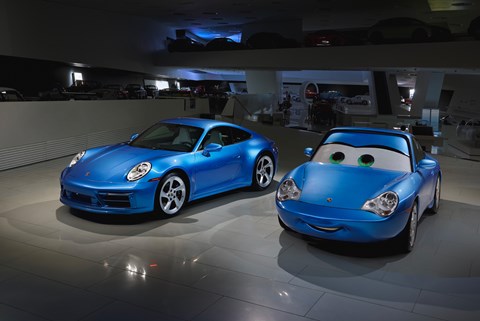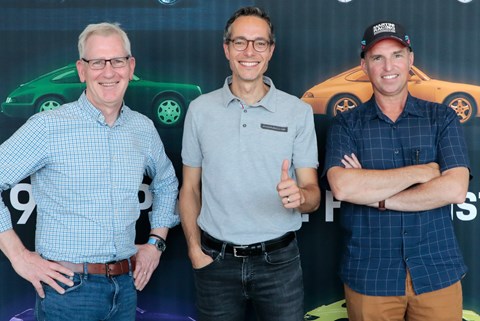► We meet the man who helped bring Cars to life
► Pixar’s movie designed to be rooted in reality
► How ‘Sally’ and co. were created
‘They’re characters that happen to be cars, not the other way around,’ says Pixar production designer Bob Pauley, sketching out Cars lead character Lightning McQueen on a piece of paper. Nearby sits long-time collaborator Jay Ward, these days Pixar’s creative director, chipping in a few anecdotes as we go.
Both are car guys – Pauley owns a 1967 Volvo P1800, Ward’s collection includes an Austin-Healey and an air-cooled Porsche 911– so while both knew Cars had to appeal beyond the car niche, their knowledge ensured an almost unbelievable level of accuracy for the 2006 film. It’s not just them; Pixar hosts an annual ‘Motorama’ for employees.
Similar attention to detail was invested in researching the landscape, with a road trip that informed backdrops and key characters too.
‘We had three Cadillacs, 10 people and we headed out on Route 66 for nine days to understand that world and the world of cars,’ Pauley recalls. ‘I was taking soil samples in Arizona – some dirt is purple, some is red – then going through Galena, Kansas, we turn the corner and there’s this old pick-up truck with a tow hook – that became Mater. We met Dawn Welch who runs the Rock Cafe in Oklahoma – she inspired the character Sally.’

Now 55, Pauley grew up in California, studied graphic design and illustration at San Jose State University and started out doing character merchandise at a theme park before moving into film animation. He worked on Tim Burton’s The Nightmare Before Christmas, joining Pixar aged 31, with Toy Story his first credit.
When Cars development began in the late 1990s, matching characters to cars and understanding how those cars would anthropomorphically express themselves was essential groundwork. The big breakthrough came as Bobby Podesta (now Pixar supervising animator) experimented with rudimentary animation models to find ways of making cars interact with one another like humans do.
Throughout, it was always important to stay true to the spirit of the cars. ‘Luigi is quick and sporty, he has narrower tyres. Sheriff is like two doughnuts away from a heart attack, so he’s a larger ’49 Mercury, he’s got soft springs, a nice kind of soft roll.’
Perhaps most intriguing is the balance Pixar’s animators had to strike between faithfully recreating the dynamic language of cars, while judging when to break free of reality.

‘We actually set the suspension up for the cars the way they would be,’ chips in Ward (pictured above, right). ‘So when McQueen and Mater are scared of Frank the combine and they’re running through a field, Mater is just drifting along because his suspension is so soggy and McQueen’s like a racecar if you drove a racecar through a field – so hard he bounces. A Fiat 500 has transverse leaf suspension – we dialled all that in.
‘But the cars don’t respect the materials, and for instance with Sally we cheated the mouth forward a little bit to get light on it, we made the windscreen much more upright and shortened the dimensions.’
Along with stock car Lightning Queen, Sally, originally conceived as a Ford Mustang (after the song) soon became a 996-generation 911.
‘A Porsche is fast enough to keep up with McQueen, the engine’s in the back so there’s no big grille that looks like a moustache and the headlights on that generation weren’t round, so they didn’t look like eyes [Pixar chose to place eyes on windscreens, not headlights],’ explains Pauley.

Given period technology, getting the cars to look natural and literally reflect the world around them was a hugely time-consuming task. ‘You had to kind of fight the symmetry to get a natural asymmetrical view of the cars, and then if you look at the reflections in Doc Hudson’s chrome as he talks, that’s literally hours and hours to render a single frame. These days things are much faster, but that just means we spend more time on other aspects.’
Ward also notes that now ‘there’s much more blending between disciplines, so the digital folks have become much more artistic and the art folks are much more technical.’
Pauley and Ward artfully dodge questions about a follow-up to 2017’s Cars 3. Almost 20 years since the first instalment, though, one thing’s certain: if Cars does return, it’ll still all start with a sketch.
The CAR Curveballs: six questions only we would ask
Tell us about your car…
‘A brown ’72 Ford Capri with a crank sunroof bought from auction in San Jose. I couldn’t drive stick so the night before I learned in a buddy’s pick-up but I still stalled the Capri in the middle of an enormous intersection on the way home.’
What is your proudest achievement?
‘Personally it has to be my wife and two wonderful kids. In the film world I think Toy Story.’
Tell us about a time you’ve screwed up…
‘I banged up the family Pinto station wagon when I connected with a concrete post in a parking lot.’
What’s the best thing you’ve ever done in a car?
‘The nine days I spent on Route 66 with the Cars team. You can look at that stuff in a book but you don’t get the feel of it.’
Supercar or classic?
‘Classic. Mid to late ’60s is a sweet spot. The GT40 is a favourite and I own a 1967 Volvo P1800. Supercars now, the forms don’t excite me as much and they seem more like financial investments.’
Curveball: is Sally a pre- or post-facelift 996 Carrera?
‘She’s a facelift, when Porsche re-did the lights [correct]. There was something neat and specific about that one.’